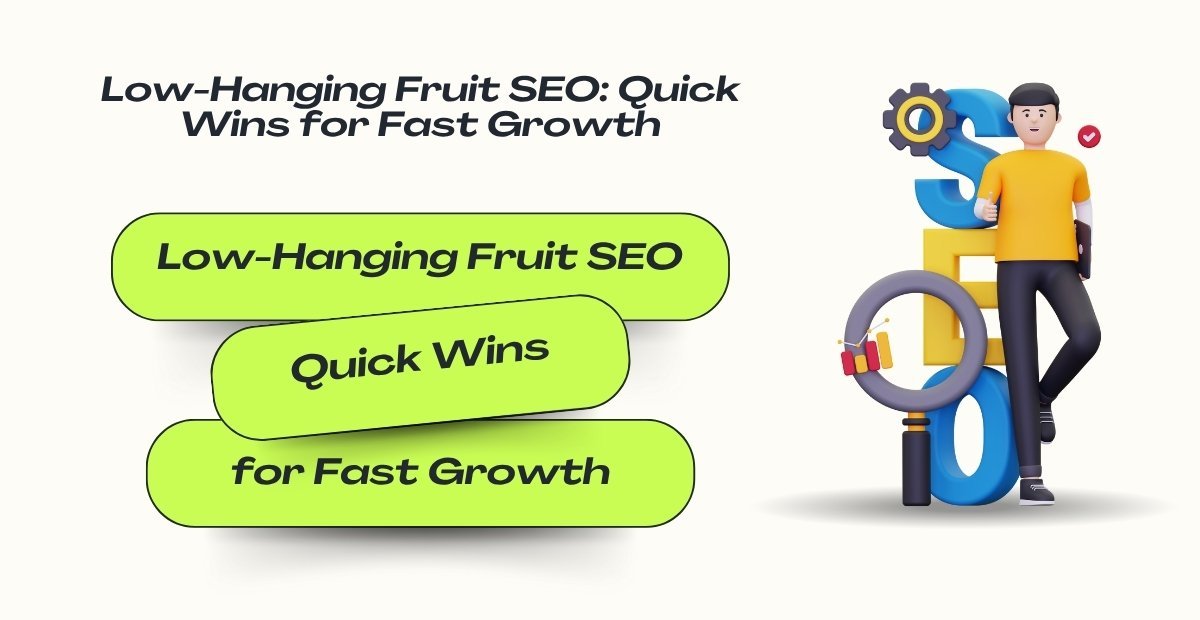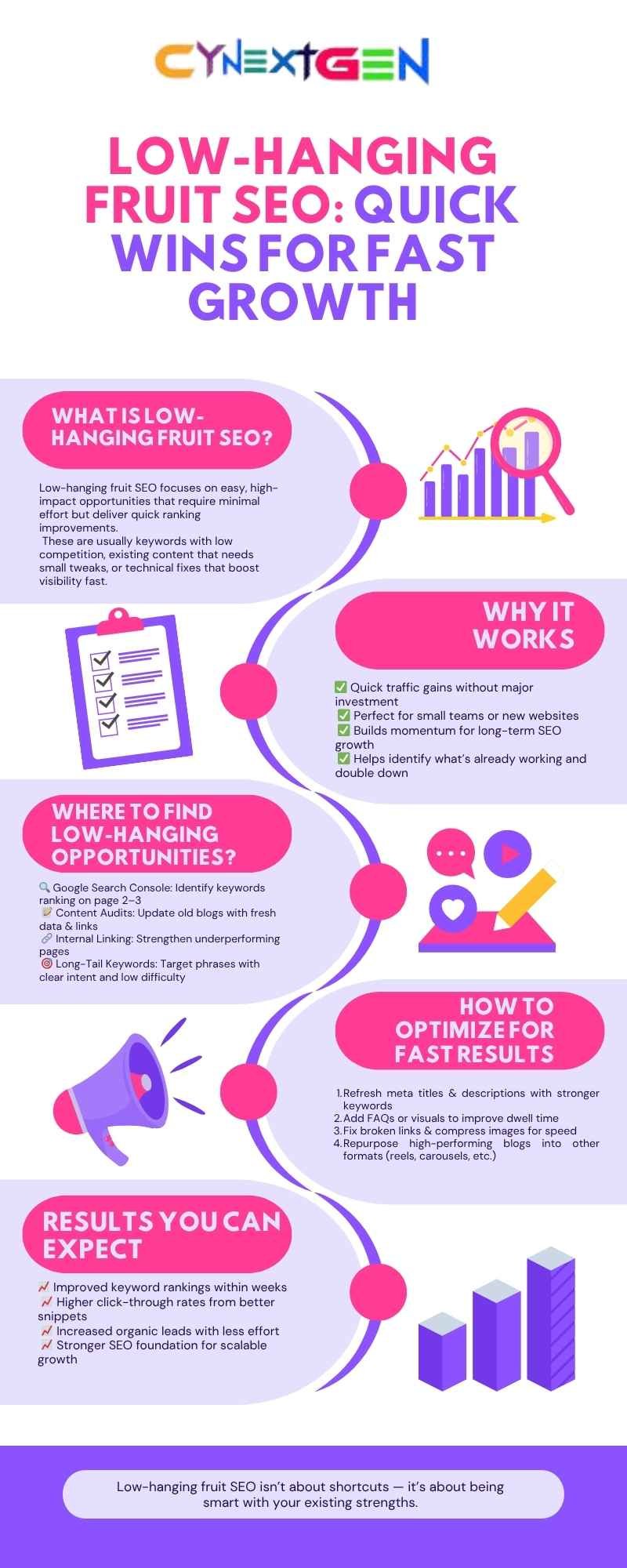
Top 10 Low-Hanging Fruit SEO Tactics for Higher Rankings
In the race for organic visibility, long-term content strategies and massive technical audits can take months, or even years, to yield substantial results. Businesses often require quick SEO wins to satisfy stakeholders and demonstrate early ROI. That is why chasing low-hanging fruit SEO is critical. Low-hanging fruit in SEO refers to optimization tasks that offer the highest return on investment (ROI) for the least amount of effort. These are the high-impact, low-effort techniques that leverage existing site authority or fix simple, obvious errors. By prioritizing these easy fixes, you can often see measurable ranking and traffic shifts within weeks, building crucial momentum and confidence for your larger, long-term SEO investments.
Top 10 Low-Hanging Fruit SEO Tactics for Higher Rankings
These ten tactics represent the most common and effective ways to achieve substantial ranking improvements with minimal development effort.
1. Keyword Optimization in Title Tags & Meta Descriptions
Your title tag and meta description are the first elements users and search engines see. Including primary keywords naturally improves visibility and click-through rate. Keep title tags under 60 characters and meta descriptions around 155. Make them descriptive, relevant, and compelling. Avoid keyword stuffing. Well-optimized metadata signals topical relevance, attracts clicks, and can significantly improve rankings.
- The Fix:
- Title Tag: Place your primary keyword as close to the beginning of the title tag as possible (ideally within the first 60 characters). Make it compelling for clicks.
- Meta Description: Write a compelling 150-160 character summary that includes your primary keyword and a call-to-action. While not a direct ranking factor, a good meta description boosts click-through rate (CTR), which is a strong positive signal.
- Why It’s Low-Hanging Fruit: It’s a simple text change in your CMS (like WordPress) that takes seconds but directly tells Google what your page is about.
2. Create and Submit an XML Sitemap
An XML sitemap helps search engines understand your site structure and crawl it efficiently. It lists key pages, ensuring that even deep or newly added content gets indexed. Submitting your sitemap to Google Search Console and Bing Webmaster Tools increases discoverability. Regularly updating the sitemap is essential for sites with frequent content changes. This step enhances site visibility and ensures search engines can access all necessary pages.
- The Fix:
-
- Use a plugin (like Yoast SEO or Rank Math) or a online generator to create an XML sitemap.
- Submit it to Google Search Console and Bing Webmaster Tools.
- Why It’s Low-Hanging Fruit: It’s a one-time setup that ensures your pages are discovered. Most CMS platforms automate this.
3. Improve Page Speed (The Easy Wins)
Fast-loading websites improve user experience and search rankings. Easy wins include compressing images, enabling browser caching, reducing server response time, and using a Content Delivery Network (CDN). Even shaving off a few seconds can reduce bounce rates and improve conversions. Google’s PageSpeed Insights or Core Web Vitals are great tools to identify and fix speed issues. Faster sites rank better and keep visitors engaged longer.
- The Fix:
- Compress Images: Use tools like ShortPixel, TinyPNG, or your CMS’s built-in compression. Never upload giant, uncompressed photos.
- Enable Caching: Use a caching plugin (e.g., W3 Total Cache, WP Rocket) to serve static versions of your pages.
- Leverage a CDN: Use a Content Delivery Network (CDN) like Cloudflare. Their free plan is excellent and easy to set up.
- Why It’s Low-Hanging Fruit: These are technical-sounding but often involve just installing and configuring a plugin.
4. Optimize for “People Also Ask” & Featured Snippets
Featured snippets and “People Also Ask” sections drive high visibility in SERPs. Structure your content to answer common questions concisely. Use H2/H3 subheadings, bullet lists, and short, direct answers. Incorporating FAQs or natural language queries can help secure these positions. Optimizing for snippets improves authority, attracts more clicks, and positions your brand as a go-to resource in your niche.
- The Fix:
-
- Find Questions: Use tools like AnswerThePublic or search your main keyword and note the “People Also Ask” questions.
- Answer Directly: Create a section on your page that directly and concisely answers each question. Use a heading (H2, H3) that matches the question and provide a clear, 1-2 sentence answer right below it.
- Why It’s Low-Hanging Fruit: It’s a simple content formatting trick. You’re not writing new articles, just restructuring existing content to answer specific questions.
5. Fix Internal Linking Issues
Internal links guide search engines and users through your website. Broken or poor linking structures can hurt crawlability and confuse users. Audit your site to identify orphaned pages and add contextual links from relevant content. Ensure anchor text is descriptive and keyword-rich. A healthy internal linking strategy improves navigation, spreads authority across pages, and boosts SEO performance by helping Google better understand site hierarchy.
- The Fix:
-
- Link to Key Pages: From your high-authority pages (like your homepage or blog posts), add contextual links to your important but lesser-known service or product pages.
- Use Descriptive Anchor Text: Instead of “click here,” use keyword-rich text like “learn more about our SEO services.”
- Why It’s Low-Hanging Fruit: You have full control over this. It takes minutes to add a few strategic links within your existing content.
6. Conduct a Basic Content Audit
A content audit identifies underperforming pages and opportunities to improve. Review traffic, rankings, and engagement metrics to find thin, duplicate, or outdated content. Refresh valuable posts with updated keywords, add multimedia, and merge overlapping topics. Remove irrelevant pages that don’t serve your SEO goals. Regular audits ensure your content stays relevant, authoritative, and competitive, directly impacting rankings and audience trust.
- The Fix:
- Identify Low-Hanging Fruit: In Google Analytics, find pages with decent traffic but high bounce rates. These are opportunities—the page is attracting the right people but not satisfying them.
- Update or Improve: Refresh the content, add more details, improve formatting, or add a clearer call-to-action.
- Find “Orphaned Pages”: These are pages with no internal links pointing to them. Find them and link to them from relevant content.
- Why It’s Low-Hanging Fruit: You’re not starting from scratch. You’re identifying existing assets that can be easily improved for a big return.
7. Optimize Images (Alt Text & File Names)
Images are powerful for SEO when optimized correctly. Use descriptive, keyword-friendly file names and write clear alt text for accessibility and search indexing. Compress images without losing quality to reduce load times. Include captions where appropriate to improve engagement. Proper image optimization improves page speed, enhances UX, and increases chances of ranking in Google Images, providing an additional traffic source.
- The Fix:
- File Name: Before uploading, rename the file from IMG_12345.jpg to a descriptive name like low-hanging-fruit-seo-tactics.jpg.
- Alt Text: Always write descriptive alt text that includes your keyword if it’s relevant. This is crucial for accessibility and image search.
- Why It’s Low-Hanging Fruit: It takes 10 seconds per image and can drive significant traffic from Google Images.
8. Claim and Optimize Your Google Business Profile (For Local SEO)
For local businesses, an optimized Google Business Profile is critical. Claim your profile and ensure all information address, phone, hours, services are accurate. Add high-quality images, respond to reviews, and post regular updates. Use local keywords in your business description. An active, complete profile boosts local visibility, improves map pack rankings, and builds trust with nearby customers searching for your services.
- The Fix:
- Claim and verify your profile.
- Fill out every single section completely and accurately (hours, photos, services, products, attributes).
- Regularly post updates and respond to reviews.
- Why It’s Low-Hanging Fruit: It’s free and gives you a dominant presence in local search results (the “Local Pack”).
9. Improve Click-Through Rate (CTR) with Better Titles
A high CTR signals to Google that your page satisfies user intent. Craft compelling titles with power words, numbers, or questions that spark curiosity. Align them with the searcher’s intent while keeping them under 60 characters. Experiment with variations using A/B testing. Strong titles not only drive more clicks but can also indirectly boost rankings by increasing engagement signals.
- The Fix:
-
- Analyze your Google Search Console performance.
- Find keywords where you rank in positions 2-10 but have a low CTR.
- Rewrite your title tag and meta description to be more compelling, using power words, numbers, or brackets. E.g., change “SEO Guide” to “10 Easy SEO Tactics [2024 Guide]”.
- Why It’s Low-Hanging Fruit: It’s a simple A/B testing process that requires no coding, just creativity.
10. Secure Your Site with HTTPS
Security is a ranking factor, and HTTPS builds trust with visitors. An SSL certificate encrypts user data, protecting against threats. Migrating from HTTP to HTTPS is straightforward with most hosting providers. Update internal links and redirect old URLs to avoid duplicate content issues. A secure site signals professionalism, increases conversions, and ensures compliance with Google’s ranking requirements.
- The Fix:
- Purchase an SSL/TLS certificate. Most quality web hosts now offer them for free (e.g., Let’s Encrypt).
- Install and activate it. Many hosts do this with one click.
- Why It’s Low-Hanging Fruit: For most modern hosts, this is a trivial task. The security and SEO benefit far outweighs the minimal effort required.
Tools to Identify Low-Hanging Fruit SEO Opportunities
Effective low-hanging fruit strategies rely heavily on accurate diagnostic tools that pinpoint specific, actionable weaknesses.
Tool Categories
- Free Tools: Google Search Console (GSC) is your most valuable asset, showing exactly which keywords are receiving high impressions but low clicks (the ideal low-CTR fix). Google Analytics 4 (GA4) helps you identify pages with high bounce rates that need content quality improvements. PageSpeed Insights highlights immediate speed fixes.
- Paid Tools: SEMrush and Ahrefs are essential for efficiently tracking low-competition keywords and performing large-scale site audits for technical errors and link analysis. SERanking and Screaming Frog excel at technical audits, identifying broken links, redirect chains, and quickly scanning metadata for optimization opportunities.
Content Tools: SurferSEO, Clearscope, and MarketMuse help quickly analyze and optimize existing content for keyword relevance and completeness, guiding your content refresh efforts with data-backed recommendations.
| Tool | Use Case | Benefit |
| Google Search Console | Identify low CTR keywords (Impressions high, Clicks low) | Quick metadata fixes for immediate traffic gains |
| Ahrefs/SEMrush | Track low-competition keywords and rank-tracking for positions 11-20 | Easy traffic gains from minimal ranking movement |
| Screaming Frog | Spot broken links, redirect chains, and missing titles/meta descriptions | Improve site health and crawl budget efficiency |
| PageSpeed Insights | Diagnose critical mobile speed issues and LCP delays | Direct improvement in Core Web Vitals score |
Why Focus on Low-Hanging Fruit SEO?
Focusing on these accessible quick wins provides immediate strategic and financial benefits that can sustain a larger SEO program.
- Faster ROI Compared to Long-Term SEO: Since you are optimizing existing content or fixing technical debt, the time to results (TTR) is dramatically shortened. You see traffic and conversion spikes often within 30 to 90 days, providing a fast and measurable SEO ROI.
- Great for Small & Mid-Sized Businesses: Websites with smaller budgets and fewer resources can use these tactics to compete effectively. They require minimal capital expenditure, relying more on strategic analysis and efficient execution than brute-force link building or massive content teams.
- Helps Improve Rankings Without Huge Budgets: By identifying the keywords you are already ranking for in positions 11-20, you avoid the expensive and time-consuming battle of ranking for position one from scratch. A simple content refresh can push these pages into the top 10.
- Builds Momentum for Bigger SEO Strategies: Demonstrating early success with quick SEO growth is crucial for securing internal buy-in. These fast wins provide the financial and political capital needed to fund the more complex, long-term projects like content infrastructure development and core site performance improvements.
Conclusion – Turning Small Fixes Into Long-Term SEO Success
Leveraging low-hanging fruit SEO tactics is the fastest path to demonstrating organic value. By systematically addressing low-CTR titles, refreshing page two content, and fixing technical defects like broken links and poor Core Web Vitals, you unlock instant growth and boost site authority. This success provides the momentum and budget necessary to pivot to long-term strategies. The key is balance: use these quick SEO wins to fund the development of deep, authoritative content hubs that will ultimately secure your top rankings for years to come.






Add Comment